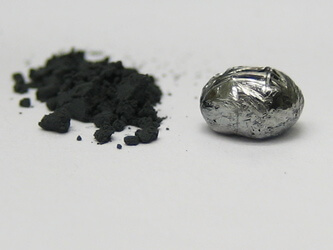Rhenium: Properties, Production, and Applications
Rhenium is a metal with very high strength, good ductility and cold working properties. It is a material used in many high-temperature applications. More than 80% of the global rhenium usage is in high-temperature superalloys for aircraft applications like turbine blades and engine parts. The remaining demand is mostly from petrochemical refining industries.

What is rhenium?
Rhenium, having the chemical symbol Re, is a rare metallic element that belongs to the transition metal group in the periodic table of elements. It is a silvery, lustrous metal with a natural concentration in the earth’s crust of about 1 part per billion [1]. Rhenium is extracted from the host ore molybdenite and porphyry copper deposits. Molybdenite ores are the primary source of rhenium as, typically, molybdenite found in porphyry copper deposits contains about 100 to 3,000 parts per million of Rhenium [2].
Rhenium properties
High melting point
Rhenium has a very high melting point, with only tungsten and carbon above it. This makes rhenium ideal in applications that require high-temperature resistance. Its melting point is at 3,185°C.
High density
Rhenium is a dense element at 21.02 grams per cubic centimetre. It ranks the fourth densest element in the periodic table of elements next to platinum, osmium and iridium. Rhenium has a compact, robust and closely packed hexagonal crystal structure.
Stable chemical properties
Generally, rhenium is a stable metal as it does not easily react with oxygen and other substances, with the exception of strong acids such as nitric and sulphuric acid [3].
How is rhenium produced?
Approximately all principal rhenium production (rhenium produced by mining rather than through recycling) is as a by-product of copper mining. Worldwide mine production of rhenium was estimated to be 50 to 60 tons annually, 50% of which was produced from the largest porphyry copper mines in Chile [4].
Rhenium recovery from flue gases in molybdenite roasting
From porphyry copper ores, 0.3 – 1.6% copper and 0.01 – 0.05% molybdenum are ground and concentrated by flotation. Molybdenite is then roasted at 500 – 700°C to produce technical-grade molybdenum trioxide, MoO3. Rhenium heptoxide, Re2O7 sublimes due to its high vapour pressure and escapes with the flue gases. Rhenium heptoxide is soluble in water and so HReO4 is formed. It is then passed through multistage pressure-jet venturi scrubbers that enable high rhenium recovery efficiencies up to 90%.
Production of rhenium metal powder and pellets
Rhenium production is also achieved through a method consisting of solvent extraction combined with electrowinning [5] of the rhenium from perchlorate solutions. Rhenium powder can be produced by the reduction of pure ammonium perrhenate NH4ReO4 in a stream of hydrogen. The first reduction stage is at 300 – 350°C to form ReO2 and the second reduction stage is at 800°C where rhenium powder is formed [3].
What is rhenium used for?
Superalloys
Rhenium is used as an additive in making superalloys together with iron, cobalt, nickel, tungsten and molybdenum. The addition of rhenium improves the overall creep strength of a superalloy, making it an excellent material for jet engine parts and gas turbine engines. For example, nickel-based alloys with 1 to 3 wt% rhenium are used as aircraft turbine blades due to their high strength and oxidation resistance.
Catalyst
Rhenium compounds are used as a catalyst for homogeneous and heterogeneous catalysis in many industries such as petrochemistry, pharmaceutical and organic synthesis processes including isomerisation, hydrogenation and alkylation. Platinum-rhenium catalysts are essential in a chemical process called catalytic reforming in petroleum refineries. This process converts petroleum naphthae from a low octane rating into high octane, unleaded, antiknock fuel products for internal combustion engines and aromatic hydrocarbons for various syntheses [6].
Thermoelements
Tungsten-rhenium and molybdenum-rhenium alloys are utilised mainly in the manufacture of thermoelements. Their uses include semiconductors, heating elements, metallic coatings and welding rods. Tungsten-rhenium alloys are used in the manufacture of rotating X-ray anodes [7].
Sources
[1] T.R. Compton, 2015, “Chapter 4 - Metals in Surface, Ground, and Mineral Waters,” Determination of Metals in Natural Waters, Sediments and Soils, Elsevier, pp. 161-178.
[2] R.D. Peacock, 2016, “Chapter 39 - Rhenium,” The Chemistry of Manganese, Technetium and Rhenium: Pergamon Texts in Inorganic Chemistry, J. C. Bailar, H. J. Emeléus, Ronald Nyholm, eds., Elsevier, pp. 905-911.
[3] H.G. Nadler, 2000, “Rhenium and Rhenium Compounds,” Ullmann's Encyclopedia of Industrial Chemistry (Ed.), doi:10.1002/14356007.a23_199
[4] “MSP-REFRAM Final Conference Rhenium Production,” 2017, from http://prometia.eu/wp-content/uploads/2017/03/8_MSP-REFRAM-Rhenium-production-SotA_W.-Kurylak.pdf
[5] “Electrowinning” n.d., from https://www.sciencedirect.com/topics/chemistry/electrowinning
[6] “Rhenium,” n.d., from http://www.chemistryexplained.com/elements/P-T/Rhenium.html
[7] “Periodic Table Rhenium,” n.d., from http://www.rsc.org/periodic-table/element/75/rhenium